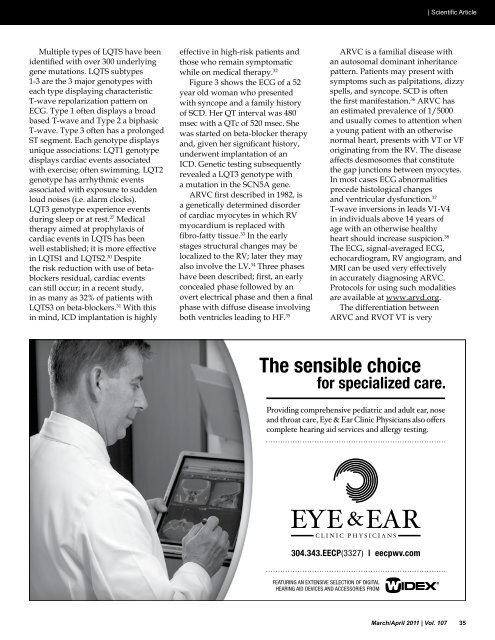March/April - West Virginia State Medical Association
March/April - West Virginia State Medical Association
March/April - West Virginia State Medical Association
Create successful ePaper yourself
Turn your PDF publications into a flip-book with our unique Google optimized e-Paper software.
| Scientific Article<br />
Multiple types of LQTS have been<br />
identified with over 300 underlying<br />
gene mutations. LQTS subtypes<br />
1-3 are the 3 major genotypes with<br />
each type displaying characteristic<br />
T-wave repolarization pattern on<br />
ECG. Type 1 often displays a broad<br />
based T-wave and Type 2 a biphasic<br />
T-wave. Type 3 often has a prolonged<br />
ST segment. Each genotype displays<br />
unique associations: LQT1 genotype<br />
displays cardiac events associated<br />
with exercise; often swimming. LQT2<br />
genotype has arrhythmic events<br />
associated with exposure to sudden<br />
loud noises (i.e. alarm clocks).<br />
LQT3 genotype experience events<br />
during sleep or at rest. 27 <strong>Medical</strong><br />
therapy aimed at prophylaxis of<br />
cardiac events in LQTS has been<br />
well established; it is more effective<br />
in LQTS1 and LQTS2. 30 Despite<br />
the risk reduction with use of betablockers<br />
residual, cardiac events<br />
can still occur; in a recent study,<br />
in as many as 32% of patients with<br />
LQTS3 on beta-blockers. 31 With this<br />
in mind, ICD implantation is highly<br />
effective in high-risk patients and<br />
those who remain symptomatic<br />
while on medical therapy. 32<br />
Figure 3 shows the ECG of a 52<br />
year old woman who presented<br />
with syncope and a family history<br />
of SCD. Her QT interval was 480<br />
msec with a QTc of 520 msec. She<br />
was started on beta-blocker therapy<br />
and, given her significant history,<br />
underwent implantation of an<br />
ICD. Genetic testing subsequently<br />
revealed a LQT3 genotype with<br />
a mutation in the SCN5A gene.<br />
ARVC first described in 1982, is<br />
a genetically determined disorder<br />
of cardiac myocytes in which RV<br />
myocardium is replaced with<br />
fibro-fatty tissue. 33 In the early<br />
stages structural changes may be<br />
localized to the RV; later they may<br />
also involve the LV. 34 Three phases<br />
have been described; first, an early<br />
concealed phase followed by an<br />
overt electrical phase and then a final<br />
phase with diffuse disease involving<br />
both ventricles leading to HF. 35<br />
ARVC is a familial disease with<br />
an autosomal dominant inheritance<br />
pattern. Patients may present with<br />
symptoms such as palpitations, dizzy<br />
spells, and syncope. SCD is often<br />
the first manifestation. 36 ARVC has<br />
an estimated prevalence of 1/5000<br />
and usually comes to attention when<br />
a young patient with an otherwise<br />
normal heart, presents with VT or VF<br />
originating from the RV. The disease<br />
affects desmosomes that constitute<br />
the gap junctions between myocytes.<br />
In most cases ECG abnormalities<br />
precede histological changes<br />
and ventricular dysfunction. 37<br />
T‐wave inversions in leads V1‐V4<br />
in individuals above 14 years of<br />
age with an otherwise healthy<br />
heart should increase suspicion. 38<br />
The ECG, signal-averaged ECG,<br />
echocardiogram, RV angiogram, and<br />
MRI can be used very effectively<br />
in accurately diagnosing ARVC.<br />
Protocols for using such modalities<br />
are available at www.arvd.org.<br />
The differentiation between<br />
ARVC and RVOT VT is very<br />
The sensible choice<br />
for specialized care.<br />
Providing comprehensive pediatric and adult ear, nose<br />
and throat care, Eye & Ear Clinic Physicians also offers<br />
complete hearing aid services and allergy testing.<br />
304.343.EECP(3327) | eecpwv.com<br />
Featuring an extensive selection oF digital<br />
hearing aid devices and accessories From<br />
<strong>March</strong>/<strong>April</strong> 2011 | Vol. 107 35















